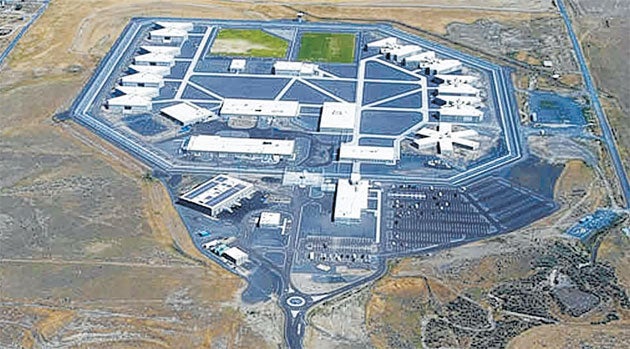Green prison: Where security meets ecology
A green prison sounds unlikely - especially in the US. But a ground-breaking facility in America wants to improve the environment as well as crime rates. By Rob Sharp

Your support helps us to tell the story
From reproductive rights to climate change to Big Tech, The Independent is on the ground when the story is developing. Whether it's investigating the financials of Elon Musk's pro-Trump PAC or producing our latest documentary, 'The A Word', which shines a light on the American women fighting for reproductive rights, we know how important it is to parse out the facts from the messaging.
At such a critical moment in US history, we need reporters on the ground. Your donation allows us to keep sending journalists to speak to both sides of the story.
The Independent is trusted by Americans across the entire political spectrum. And unlike many other quality news outlets, we choose not to lock Americans out of our reporting and analysis with paywalls. We believe quality journalism should be available to everyone, paid for by those who can afford it.
Your support makes all the difference.Environmentally friendly prisons. Liberals think they're a no-brainer, right-wingers might view them as just another hand in the public purse. Do the world's incarcerated now have a responsibility to save the planet?
The Washington State Department of Corrections seems to think so. This week, the US Green Building Council awarded the department North America's most prestigious environmental award – a plaque for Leadership in Energy and Environmental Design – for a 21-building, medium-security extension at its Coyote Ridge Corrections Centre in Connell, a small city in the state's Franklin County. Since the extension's completion in October 2008, each year the penitentiary uses 5.5 million gallons less water than its conventional equivalents, saving its operators around $370,000 (£235,807) in energy costs over the period. Its solar panels occupy 16,929sq ft and it floods its corridors with natural light. But is this money well-spent? The 19th-century philosopher Jeremy Bentham, whose theories considered prison design, once said: "The greatest happiness of the greatest number is the foundation of morals and legislation." It must follow that Coyote Ridge's all-encompassing social, humanitarian and environmental benefits speak for themselves.
"Every aspect of a prison design, from its staff to its location, is important," says Sean McConvill, co-author of the influential British book Prison Design. "Among these, no doubt, is respect for the environment and careful use of resources, which must have a beneficial impact on staff and inmates alike."
Indeed, Coyote Ridge's staff are congratulating themselves. The prison's facility manager, Glenn Jones, told reporters this month the jail had performed "better than we hoped". He described how its laundry system reduced reliance on a local aquifer, and how a rubbish recycling programme had cut the amount of waste produced by a half, impressing local legislators.
Environmentally, at the very least, it is easy to see why the $230m (£147m) extension has picked up a gong. From the outside, the barbed wire and monolithic concrete blocks make it look like any other correctional outpost. But then, visitors catch a glimpse of a "drought-resistance landscape" of gravel instead of thirsty grass (cutting water use by 25 per cent). In a 100-bed segregation unit and eight 256-bed units of inmate housing, state-of-the-art, long, thin windows keep cells cool in summer and retain heat in winter. Efficient boilers and ventilation systems help the prison slash its energy consumption by half. Building materials that don't contain volatile organic compounds make the interior more habitable.
For the psychological benefits, compare this to its British cousins, maligned for their oppressive, cramped designs. "It is the idea of punishment heaped on punishment," the progressive British architect Will Alsop said of British prisons in 2007. "The punishment [to inmates] is being taken out of society. That's fine. Not even the prisoners complain about that ... but they're being punished further. Why can't they have a shower in their cell?" That year, Alsop spearheaded The Creative Prison exhibition at east London's Yard Gallery, showcasing alternatives. His suggestions included "villages of smaller buildings" instead of large cell blocks, and allotments reminiscent of a high-security university campus. Coyote Ridge operates along similar lines: there's no reason to think its inmates won't benefit from "hybrid housing units", allowing increased movement for inmates who behave well but cannot be transferred to a minimum-security jail.
Then there are the social benefits. According to Prison Design, "a prison system can only function properly where there is a balance between security and a human environment, and buildings that will facilitate positive activities with staff and prisoners". The authors highlight inmates' frustration regarding "lack of freedom and movement" and an inability to manipulate their immediate environment. Coyote Ridge's modern ethos and hybrid accommodation are mitigating factors. Indeed its balance, as the authors see it, between "security requirements and over-oppressive atmosphere" is likely to stave off inmate hostility – reducing jealousy for resources, for example – and encourage acceptable behaviour. It's likely to reduce the ill-effects on staff and save taxpayers' money.
"The key to the success of the project was the team that planned, designed and constructed the new prison," said the state department. "Innovation and cost savings were provided by every member of the team." You'd equally hope the benefits will be felt by every one of the prison's 2,200 inmates.
Join our commenting forum
Join thought-provoking conversations, follow other Independent readers and see their replies
Comments